Outline of sharks
The following outline is provided as an overview of and topical guide to sharks:
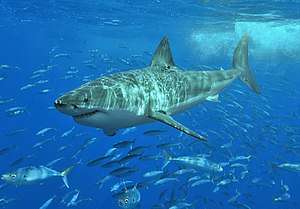
A great white shark at Isla Guadalupe, Mexico
Sharks (superorder Selachimorpha) are a type of fish with a full cartilaginous skeleton and a highly streamlined body. The earliest known sharks date from more than 440 million years ago, before the time of the dinosaurs.[1]
Fields that study sharks
- Ichthyology – branch of zoology devoted to fish (including sharks)
- Meristics – branch of ichthyology that relates to counting features of fish, such as the number of fins or scales
What is a shark?
A shark, also called a "selachimorph", can be described as all of the following:
- Animal – multicellular, eukaryotic organism of the kingdom Animalia or Metazoa. An animal's body plan eventually becomes fixed as it develops, although some types of animal undergo a process of metamorphosis later on in their life. Most kinds of animal are motile, meaning they can move spontaneously and independently.
- Chordate – Chordates (phylum Chordata) are animals which are either vertebrates or one of several closely related invertebrates.
- Fish – gill-bearing aquatic vertebrate (or craniate) animal that lacks limbs with digits.
- Chondrichthye (cartilaginous fish) – jawed fish with paired fins, paired nares, scales, two-chambered hearts, and skeletons made of cartilage rather than bone.
- Elasmobranch – member of the subclass Elasmobranchii, which includes sharks, rays, and skates.
- Chondrichthye (cartilaginous fish) – jawed fish with paired fins, paired nares, scales, two-chambered hearts, and skeletons made of cartilage rather than bone.
- Fish – gill-bearing aquatic vertebrate (or craniate) animal that lacks limbs with digits.
- Chordate – Chordates (phylum Chordata) are animals which are either vertebrates or one of several closely related invertebrates.
- Predator – organism that attacks and feeds on prey (the organism that is attacked).[2]
- Apex predator – some shark species are apex predators, that is, predators with no predators of their own, residing at the top of their food chain.[3]
Biological classification
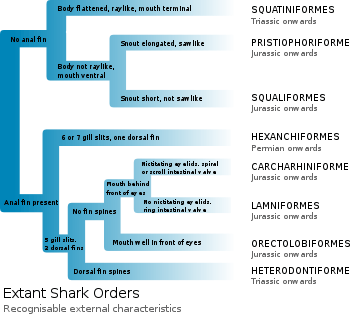
Identification of the 8 extant shark orders
- Kingdom: Animalia
- Phylum: Chordata
- Class: Chondrichthyes
- Subclass: Elasmobranchii
- Superorder: Selachimorpha
Types of sharks
List of sharks Subdivisions of the biological classification Selachimorpha include:
- Carcharhiniformes – ground sharks
- Heterodontiformes – bullhead sharks
- Hexanchiformes – the five extant species of the most primitive types of sharks
- Lamniformes – mackerel sharks
- Orectolobiformes – includes carpet sharks, including zebra sharks, nurse sharks, wobbegongs, and the whale shark
- Pristiophoriformes – includes sawsharks
- Squaliformes – includes gulper sharks, bramble sharks, lantern sharks, rough sharks, sleeper sharks and dogfish sharks
- Squatiniformes – angel sharks
- † Cladoselachiformes
- † Hybodontiformes
- † Symmoriida
- † Xenacanthida (Xenacantiformes)
Shark behavior

The Philadelphia Inquirer report of Jersey Shore shark attack.
- Predation
- Shark threat display – Behaviour shown by some sharks when threatened
- Spy hopping – Raising the head out of the water
Shark attacks
- International Shark Attack File
- List of fatal, unprovoked shark attacks in the United States
- Jersey Shore shark attacks of 1916 – series of shark attacks along the coast of New Jersey between July 1 and July 12, 1916[4]
- Summer of the Shark – the name given to the summer of 2001 by American media outlets capitalizing on a bull shark attack and subsequent shark attacks [5]
Range and habitats of sharks
Range
- Bodies of water in which sharks can be found include:
- Seas: all
- Freshwater – some species of shark can live both in seawater and freshwater, and include:
- Depths: from the surface down to depths of 2,000 metres (6,600 ft).
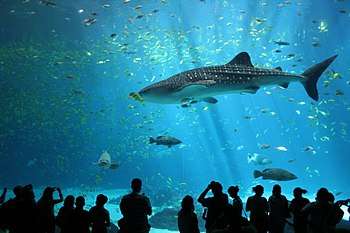
A whale shark in the Georgia Aquarium
Habitats
- White Shark Cafe – remote mid-Pacific Ocean area noted as a winter and spring habitat of otherwise coastal great white sharks
Sharks in captivity
- Shark tank
- Shark tunnel – underwater tunnel that passes through an aquarium that keeps sharks
Shark anatomy
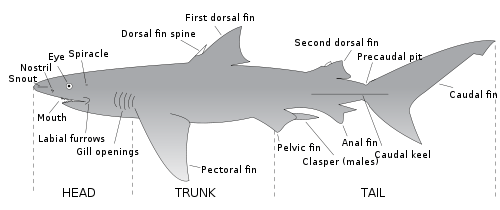
The major features of sharks
- Physical characteristics of sharks – shark skeleton, respiration and skin
- Dermal denticle – small outgrowths which cover the skin of sharks
- Ampullae of Lorenzini – sensing organ that helps sharks and fish to sense electric fields
- Electroreception – the biological ability to perceive electrical impulses (see also Ampullae of Lorenzini)
- Lateral line – sense organ that detects movement and vibration in the surrounding water
- Shark cartilage – material that a sharks' skeleton is composed of
- Shark teeth
- Spiracle – pumps water across gills
- Clasper – the anatomical structure that male sharks use for mating
- Fish anatomy – generic description of fish anatomy
Protective equipment

Simplified diagram of shark net
- Drum lines
- Shark net – submerged net placed around beaches to reduce shark attacks on swimmers
- Shark proof cage – cage from which a SCUBA diver can examine sharks more safely
- Shark repellent – method of driving sharks from an area, object, person, or animal
- Magnetic shark repellent – use of permanent magnets to repel sharks
- Protective oceanic device – first successful electronic shark repellent
- Shark suit
Shark fishing

Shark fishing boat off the Galapagos, Ecuador
- Drivers of the shark trade
- Land-based shark fishing – fishing for sharks from land such as a beach, shoreline, jetty, pier, or bridge
- Shark finning–the removal of shark fins for commercial purposes
Shark conservation
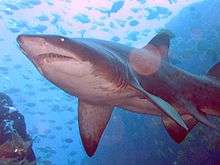
One of the first species of shark to be protected was the Grey nurse shark
- 1992 Cageless shark-diving expedition – first publicized cageless dive with great white sharks which contributed to changing public opinions about the supposed "killing machine"
- Shark Alliance – coalition of nongovernmental organizations dedicated to restoring and conserving shark populations by improving European fishing policy
- Shark Conservation Act – proposed US law to protect sharks
- Shark sanctuary – Palau's first-ever attempt to prohibit taking sharks within its territorial waters
- Shark tourism – form of ecotourism showcasing sharks
- Shark Trust – A UK organisation for conservation of sharks
Notable sharks
- Stronsay Beast – large, dead creature washed ashore on Stronsay, in the Orkney Islands, after a storm in 1808, later presumed to be a basking shark
Notable researchers and people

Hans Hass, diving pioneer
- Peter Benchley – author of the novel Jaws, later worked for shark conservation
- Eugenie Clark – American ichthyologist researching poisonous fish and the behavior of sharks; popularly known as The Shark Lady
- Leonard Compagno – international authority on shark taxonomy, best known for 1984 catalog of shark species (FAO)
- Jacques-Yves Cousteau – French naval officer, explorer, ecologist, filmmaker, innovator, scientist, photographer, author and researcher who studied the sea and all forms of life in water including sharks
- Ben Cropp – Australian former shark hunter, who stopped in 1962 to produce some 150 wildlife documentaries
- Richard Ellis – American marine biologist, author, and illustrator.
- Rodney Fox – Australian film maker, conservationist, survivor of great white shark attack and one of the world's foremost authorities on them
- Andre Hartman – South African diving guide best known for free-diving unprotected with great white sharks
- Hans Hass – diving pioneer, known for shark documentaries
- Mike Rutzen – great white shark expert and outspoken champion of shark conservation; known for free diving unprotected with great white sharks
- Ron & Valerie Taylor – ex-spearfishing champions who switched from killing to filming underwater documentaries
- Rob Stewart (filmmaker) – Canadian photographer, filmmaker and conservationist. He was best known for making and directing the documentary film Sharkwater
gollark: TAKE THAT!
gollark: You might have 8 proxies, but I have *9* antiproxies!
gollark: I have a virtual reverse antiproxy backtracing you with a binary tree at layer 5 using the darknet and serverless machine learning.
gollark: Join now!
gollark: My server's at `255.255.255.255`.
See also
References
- Martin, R. Aidan. "Geologic Time". ReefQuest. Retrieved 2006-09-09.
- Begon, M., Townsend, C., Harper, J. (1996). Ecology: Individuals, populations and communities (Third edition). Blackwell Science, London. ISBN 0-86542-845-X, ISBN 0-632-03801-2, ISBN 0-632-04393-8.
- "apex predator". PBS. Retrieved 2010-01-25.
- Fernicola, Twelve Days of Terror
- "Summer of the Shark". Time. July 30, 2001. Retrieved May 20, 2010.
External links
This article is issued from Wikipedia. The text is licensed under Creative Commons - Attribution - Sharealike. Additional terms may apply for the media files.